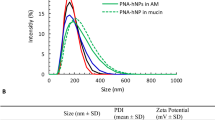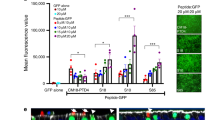Abstract
Repeat administration of gene therapy for cystic fibrosis is likely to be essential for long-term clinical efficacy. This may be minimized by the use of slow-release gene transfer preparations with more prolonged expression and longer dosing intervals for the patient. Poly(D-L-lactide-co-glycolide) (PLG) is a biodegradable and biocompatible polymer that has been used to encapsulate plasmid DNA. PLG-DNA microspheres were generated and characterized with respect to morphology, size (80% of particles <5.2 μm), and encapsulation efficiency (50.7±2.3%, n=6). Gel electrophoresis of DNA re-extracted from the microspheres confirmed that despite a decrease in the proportion of supercoiled conformation, it had not been degraded by the preparation process. Gene transfer efficiency was tested using microspheres encapsulating the reporter gene β-galactosidase in vitro on Cos 7 cells and a CF airway epithelial line (CFTEo∼) and ex vivo in a sheep tracheal (s.t.) model. In both cases, transgene exression was significantly (P<0.01) lower at the first time point tested (24 h in vitro, 48 h ex vivo) compared to lipid-#67-mediated gene transfer. However, PLG-mediated expression in vitro was sustained at 48 h, while lipid #67-mediated expression levels had dropped significantly (P<0.05) to 50.3±13.7 and 38.2±2.7% (Cos 7 and CFTEo∼ cells, respectively) of the 24-h level. This pattern was also seen in the s.t. model where at 72 h, PLG-mediated expression was 125.4±7.2% of the 48-h level demonstrating significantly (P<0.05) better retention of transfection efficiency than lipid #67, where levels had fallen to approximately half the 48 h level. By 96 h, expression was still retained in the PLG-transfected group (87.3±12.5% of 48 h expression) but was undetectable in the lipid -#67-transfected s.t. Finally, PLG microspheres, encapsulating the reporter gene chloramphenicol transferase (CAT, 80 μg) were instilled intranasally into Balb/C mice. Compared to lipid-#67-mediated delivery, where whole lung CAT expression was highest at 48 h (13.7 × 103±0.05 CAT U/μg protein, n=6) and then not detectable at further time points, CAT expression was not detectable in PLG-transfected mice at 48 h, but was detectable at 7, 14 and 21 days after transfection. These data demonstrate that PLG-mediated gene transfer can produce prolonged gene expression in airway epithelia. However, gene transfer efficiency still requires significant improvement.
This is a preview of subscription content, access via your institution
Access options
Subscribe to this journal
Receive 12 print issues and online access
$259.00 per year
only $21.58 per issue
Buy this article
- Purchase on Springer Link
- Instant access to full article PDF
Prices may be subject to local taxes which are calculated during checkout






Similar content being viewed by others
References
Stern M, Alton EWFW . Taking stock of gene therapy for cystic fibrosis. Resp Res 2000; 1: 78–81.
Bonadio J et al. Localized, direct plasmid gene delivery in vivo: prolonged therapy results in reproducible tissue regeneration. Nat Med 1999; 5: 753–759.
Ochiya T et al. New delivery system for plasmid DNA in vivo using atelocollagen as a carrier material: the minipellet. Nat Med 1999; 6: 707–710.
Truong-Le VL, August JT, Leong KW . Controlled gene delivery by DNA-gelatin nanospheres. Hum Gene Therapy 1998; 9: 1707–1717.
Capan Y et al. Preparation and characterisation of poly (D,L-lactide-co-glycolide) microspheres for controlled release of poly(L-lysine) complexed plasmid DNA. Pharm Res 1999; 16: 509–505.
Cohen H et al. Sustained delivery and expression of DNA encapsulated in polymeric nanoparticles. Gene Therapy 2000; 7: 1896–1905.
Elridge J et al. Biodegradable microphseres as a vaccine delivery system. Mol Immunol 1991; 28: 287–294.
Jones D et al. Poly (DL-lactide-co-glycolide)-encapsulated plasmid DNA elicits systemic and mucosal antibody responses to encoded protein after oral administration. Vaccine 1997; 15: 814–817.
Chen SC et al. Protective immunity induced by oral immunization with a rotavirus DNA vaccine encapsulated in microparticles. J Virol 1998; 72: 5757–5761.
Hedley M, Curley J, Urban R . Microspheres containing plasmid-encoded antigens elicit cytotoxic T-cell responses. Nat Med 1998; 4: 365–368.
Yeh MK . The stability of insulin in biodegradable microparticles based on blends of lactide polymers and polyethylene glycol. J Microencapsul 2000; 17: 743–756.
Genta I et al. Enzyme loaded biodegradable microspheres in vitro ex vivo evaluation. J Control Release 2001; 77: 287–295.
Ertl B, Platzer P, Wirth M, Gabor F . Poly (DL-lactide-co-glycolic acid) microspheres for sustained delivery and stabilization of camptothesin. J Control Release 1999; 61: 305–317.
Cleland JL et al. Development of poly (D,L-lactide-coglycolide) microsphere formulation containing recombinant human vasular endothelial growth factor to promote local angiogenesis. J Control Release 2001; 72: 13–24.
Wang D, Robinson DR, Kwon GS, Samuel J . Encapsulation of plasmid DNA in biodegradable poly(DL-lactide-co-glycolic acid) microspheres as a novel approach for immuno-gene delivery. J Control Release 2000; 69: 249–259.
Kitson C et al. The extra- and intracellular barriers to lipid and adenovirus-mediated pulmonary gene transfer in native sheep airway epithelium. Gene Therapy 1999; 6: 534–546.
Lee ER et al. Detailed analysis of structures and formulations of cationic lipids for efficient gene transfer to the lung. Hum Gene Ther 1996; 7: 1701–1717.
Riordan JR et al. Identification of the cystic fibrosis gene: cloning and characterisation of the complementary DNA. Science 1989; 245: 1066–1073.
Johnson LG et al. Efficiency of gene transfer for restoration of normal airway epithelial function in cystic fibrosis. Nat Genet 1992; 2: 21–25.
Johnson LG et al. Normalisation of raised sodium absorption and raised calcium-mediated chloride secretion by adenovirus-mediated expression of cystic fibrosis transmembrane conductance regulator in primary human cystic fibrosis airway cells. J Clin Invest 1995; 95: 1337–1382.
Berkland C, Kim K, Pack DW . Fabrication of PLG microspheres with precisely controlled and monodisperse size distributions. J Control Release 2000; 73: 59–74.
Witt C, Kissel T . Morphological characterisation of microspheres, films and implants prepared from poly(lactide-co-glycolide) and ABA triblock copolymers: is the erosion controlled by degradation, swelling or diffusion? Eur J Pharm Biopharm 2001; 51: 171–181.
Suarez S et al. Airways delivery of rifampicin microparticles for the treatment of tuberculosis. J Antimicrob Chemotherapy 2001; 48: 431–434.
Bergan D, Galbraith T, Sloane DL . Gene transfer in vitro and in vivo by cationic lipids is not significantly affected by levels of supercoiling of a reporter plasmid. Pharm Res 2000; 17: 967–973.
Hao T, McKeever U, Hedley ML . Biological potency of microsphere encapsulated plasmid DNA. J Control Release 2000; 69: 249–259.
Evora C et al. Relating the phagocytosis of microparticles by alveolar macrophages to surface chemistry – the effect of 1,2-dipalmitoylphosphatidylcholine. J Control Release 1998; 5: 143–152.
Akhtar S, Lewis KJ . Antisense oligonucleotide delivery to cultured macrophages is improved by incoporation into sustained-release biodegradable polymer microspheres. Int J Pharm 1997; 151: 57–67.
Edwards DA et al. Large porous particles for pulmonary drug delivery. Science 1997; 276: 1868–1871.
Caplen NJ et al. Gene therapy for cystic fibrosis in humans by liposome-mediated DNA transfer: the production of resources and the regulatory process. Gene Therapy 994; 1: 139–147.
Barman S, Lunsford L, Chamber P, Hedley ML . Two methods for quantifying DNA extracted from poly(lactide-co-glycolide) micropheres. J Control Release 2000; 69: 337–344.
Gluzman Y . SV-40 transformed simian cells support the replication of early SV-40 mutants. Cell 1981; 23: 175–182.
Cozens AL et al. Characterisation of immortal cystic fibrosis tracheobronchial gland epithelial cells. Proc Natl Acad Sci USA 1992; 89: 5171–5175.
Hillery E, Cheng SH, Geddes DM, Alton EWFW . Effects of altering dose on cationic liposome-mediated gene transfer to the respiratory epithelium. Gene Therapy 1999; 6: 1313–1316.
Bradford MM . A rapid and sensitive method for the quantitation of microgram quantities of protein utilising the principle of protein–dye binding. Anal Biochem 1976; 72: 248–254.
Caplen NJ et al. In vitro liposome-mediated DNA transfection of epithelial cell lines using the cationic liposome DC-Chol/DOPE. Gene Therapy 1995; 2: 603–613.
Acknowledgements
We thank Ann Dewar (Electron Microscopy, Imperial College at the National Heart and Lung Institute) for her help with the electron microscopy studies and Professor C Marriott and Mr Steve Ingham (Department of Pharmacy, King College of London) for their assistance with sizing analysis of the PLG polymers. These studies were funded by the Wellcome Trust, the Cystic Fibrosis Research Trust and by a Wellcome Trust Senior Clinical Fellowship (EWFWA).
Author information
Authors and Affiliations
Rights and permissions
About this article
Cite this article
Stern, M., Ulrich, K., Geddes, D. et al. Poly (D, L-lactide-co-glycolide)/DNA microspheres to facilitate prolonged transgene expression in airway epithelium in vitro, ex vivo and in vivo. Gene Ther 10, 1282–1288 (2003). https://doi.org/10.1038/sj.gt.3301994
Received:
Accepted:
Published:
Issue Date:
DOI: https://doi.org/10.1038/sj.gt.3301994
Keywords
This article is cited by
-
Current Progress and Challenges in the Study of Adjuvants for Oral Vaccines
BioDrugs (2023)
-
Beyond cystic fibrosis transmembrane conductance regulator therapy: a perspective on gene therapy and small molecule treatment for cystic fibrosis
Gene Therapy (2019)
-
PLGA-based gene delivering nanoparticle enhance suppression effect of miRNA in HePG2 cells
Nanoscale Research Letters (2011)
-
Gene delivery by surface immobilization of plasmid to tissue-engineering scaffolds
Gene Therapy (2010)
-
Acidic Microclimate pH Distribution in PLGA Microspheres Monitored by Confocal Laser Scanning Microscopy
Pharmaceutical Research (2008)



